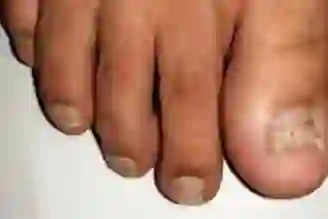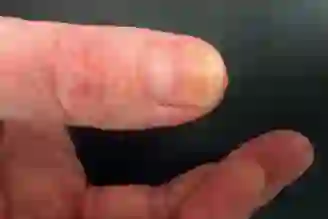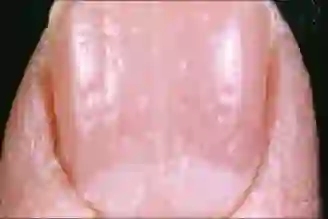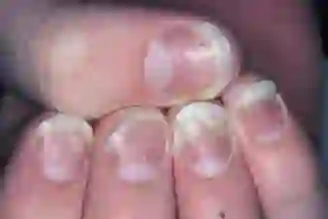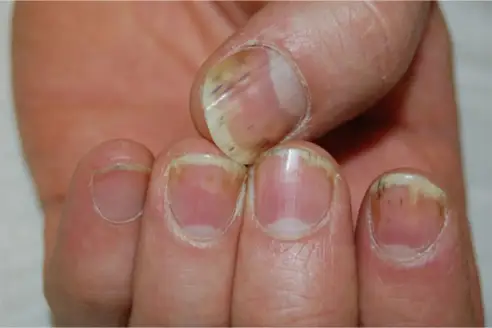
Nail psoriasis—that is, psoriasis that affects your nails—is common. It’s estimated that 50% of those with the chronic inflammatory skin condition will also experience symptoms of it on their fingernails and/or toenails. Nail psoriasis is also notoriously difficult to treat, which makes it frustrating for anyone dealing with the telltale signs on their nails. Think dents, discoloration, and nails separating from your fingers or toes, according to the American Academy of Dermatology (AAD).
One way doctors help decide where a particular case falls on the continuum from mild to severe nail psoriasis is with a scale. Much like the PASI, or Psoriasis Area and Severity Index, is used to measure the severity of plaque psoriasis all over the body, both the Severity of Nail Psoriasis Score (SNAPS) and the Nail Psoriasis Severity Index (NAPSI) are used specifically to measure psoriasis of the nails. The two scores guide treatment options and help measure the success of medication.
These tools are often used in studies, but they’re also relied on in doctors’ offices as well. Of the two, the NAPSI is the more thorough—and the more time-consuming to tabulate. And while you don’t need to use it yourself—your doctor may determine your NAPSI score—you may hear it mentioned along the way. Here is what you need to know about the NAPSI and how it works.
How Is the NAPSI Different From the SNAPS?
The NAPSI is a method of measuring the severity of nail psoriasis, explains Dendy Engelman, M.D., a board-certified cosmetic dermatologist and Mohs surgeon at Shafer Clinic in New York City. “The NAPSI score is determined by using imaginary lines to divide the nail bed and nail matrix (where the nail is produced) into four equal segments,” Dr. Engelman explains. “Each segment is scored to create an overall number that is your NAPSI score.”
The eight symptoms the quadrants are accessed for, according to research in the Journal of Rheumatology, include:
Pitting (dents or grooves in the nails)
Leukonychia (crumbling of the nail)
Red spots on the lunula (the semicircle at the base)
White lines or dots
Salmon-colored patches
Onycholysis (separation of the nail from the nailbed)
Hyperkeratosis (a chalky substance found under the nails)
Splinter hemorrhages (small areas of blood under the nails)
For each, a number of zero (meaning no sign present) or one (meaning the symptom is observed) is given, for a potential total of up to 32 per nail, with an overall score range of zero to 160 for all 20 nails of the fingers and toes. The most common of these symptoms, according to research in the journal Clujul Medical, is pitting, followed by salmon patches and hyperkeratosis.
There’s also a modified version of the NAPSI (called the mNAPSI) that does the scoring for the entire nail versus using quadrants with different scoring metrics. Four abnormalities (eukonychia, splinter hemorrhages, hyperkeratosis, and red spots in the lunula) are each scored with either a zero or one; and onycholysis, salmon-colored patches, and pitting are each scored from zero to three. This version is considered superior by some experts for eliminating variation within nail quadrants and being faster (since each nail is scaled once versus four times). And in recent years, there have been some suggestions to update the list of symptoms, including a recommendation in the Journal of the American Academy of Dermatology to add longitudinal ridges and nailfold involvement, and eliminate leukonychia from the list entirely. However, more research would need to be done before those updates are made, per Dr. Engelman.
Sign up for our bi-monthly Psoriasis Newsletter.
Your privacy is important to us.
The SNAPS, on the other hand, looks at each nail of the hands or feet as a whole (rather than in quadrants) for just four clinical features, according to Anar Mikailov, M.D., a board-certified dermatologist at Rochester Regional Hospital in Rochester, NY. They are:
Pitting
Onycholysis
Hyperkeratosis
Severe nail deformity
Much like with the NAPSI, each nail is assigned a zero (for no presence) or one (for present) for a possible total of 40 for the fingernails only.
Research presented at the 2019 American College of Rheumatology/Association of Rheumatology Professionals annual meeting found that there was a strong correlation between the scoring of the SNAPS and the mNAPSI, indicating that they have similar reliability. But Dr. Mikailov points out that while the NAPSI “is much more specific and detailed,” the SNAPS is quicker to tabulate. So, since they provide similar results, many health care providers prefer the SNAPS.
How Is the Nail Psoriasis Severity Index Used?
“Doctors determine the severity of a case of nail psoriasis based on the NAPSI score calculated,” says Dr. Engelman. “This serves as a guideline for prescribing the appropriate treatment methods.”
For example, some treatments like biologics are reserved for more severe cases of nail psoriasis, as they come with the potential for side effects. But if the case scores higher on the NAPSI scale, those side effects may be worth the risks to better address the underlying inflammation which is driving the nail psoriasis, notes Dr. Engelman.
That’s because nail psoriasis is an important predictor of enthesitis, or inflammation of the area where a tendon or ligament meets the bone, which is associated with the development of psoriatic arthritis, according to research in the Journal of Rheumatology. What’s more, nail psoriasis is also associated with greater disease severity in general as well as lower quality of life scores.
Beyond that, the NAPSI is also used to gauge any changes in nail psoriasis symptoms. “Once treatment begins, doctors may also use the NAPSI to evaluate the treatment or progression of the psoriasis,” explains Dr. Engelman. That means if a treatment shows no improvement in lowering the NAPSI score, the doctor will then move on to another option.
What Does the Score of the Nail Psoriasis Severity Index Mean?
Your NAPSI score helps determine where your case of nail psoriasis is on the continuum between mild to severe. Dr. Engelman explains, “A score of zero indicates that the patient displays no symptoms of psoriasis. The higher the score—up to 160—for a patient, the more severe the nail psoriasis.”
But there’s no need to memorize the totals for each nail, your overall score, or even if your doctor used the NAPSI, mNAPSI, or SNAPS. Just know that your doctor will keep an eye on it, and the hope is for the score to go down and not up!
Treatment of Nail Psoriasis Based on Severity
Once your doctor has gauged the extent of your symptoms, they will determine which medications are appropriate to prescribe. Some of the treatment options for mild cases of nail psoriasis include:
Calcipotriol, a vitamin D derivative ointment, applied at night, that addresses buildup under the nail by exfoliating or descaling the plaque.
Tazarotene, a topical retinoid cream (or gel) that addresses nail separation and discoloration by regulating skin cell growth.
Topical or injected corticosteroids to reduce inflammation and to reduce symptoms.
If you don’t show improvement with those treatments or your nail psoriasis is considered more advanced, there are options reserved for moderate or severe cases as they are associated with increased side effects or irritation. According the Cleveland Clinic, these treatments may include:
Phototherapy (the use of UV light to reduce inflammation
Biologics like methotrexate (Jylamvo, Maxtrex, Methofill, Metoject, Nordimet, Zlatal)
Soriatane (Acitretin), an oral retinoid that slows the overgrowth of skin cells seen in psoriasis
When to See a Doctor for Nail Psoriasis
If you suspect you may have nail psoriasis, you should have it checked out by your health care provider “as soon as possible” says Dr. Mikailov.“First, you will need to make sure the diagnosis is correct. Then early treatment will lead to quicker results!” he insists. If your first stop is a primary care physician, they may prescribe the necessary treatment themselves or refer you to a dermatologist.
From there, your doctor can help guide you on what to expect from treatment. “There is no cure for psoriasis, including nail psoriasis,” reminds Dr. Engelman. And nail psoriasis can be tough to get rid of. One of the reasons? “Nails grow slowly,” explains Dr. Engleman. “And the thickness of nails—especially in individuals with particularly thick nails—can also be an obstacle to the absorption of topical treatments.” She also adds that successful treatment requires consistency of treatment over six months or more.
One of the biggest benefits of the NAPSI test is its reliability. A study published in Arthritis Care and Research found that individuals with nail psoriasis tend to receive a consistent NAPSI score, regardless of the health care professional administering the test.
Takeaways
If you have nail psoriasis, your NAPSI score—or SNAPS score—can be the guiding tool of your treatment routine. It can help your doctor gauge not only what treatments to try but how they work along the way. Just remember to hang in there as you wait to see signs of improvement in your nail psoriasis: It may take months to hear the good news that your NAPSI score has been reduced.
